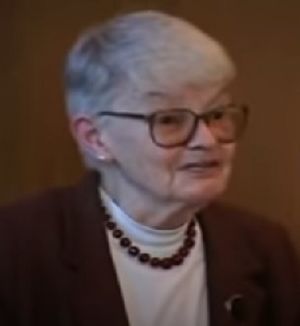Judith Jarvis Thomson facts for kids
Quick facts for kids
Judith Jarvis Thomson
|
|
|---|---|

Judith Jarvis Thomson in 2005
|
|
| Born |
Judith Jarvis
October 4, 1929 New York City, U.S.
|
| Died | November 20, 2020 (aged 91) Cambridge, Massachusetts, U.S.
|
| Alma mater | Barnard College (BA) Cambridge University (BA, MA) Columbia University (PhD) |
| Spouse(s) |
James Thomson
(m. 1962; div. 1980) |
| Era | Contemporary philosophy |
| Region | Western philosophy |
| School | Analytic philosophy |
| Doctoral students | Kathrin Koslicki |
|
Notable ideas
|
The trolley problem, ethics concerning ... |
Judith Jarvis Thomson (born October 4, 1929 – died November 20, 2020) was an American philosopher. She spent her life studying and working on big questions about right and wrong (called ethics) and the nature of reality (called metaphysics).
She is most famous for her work on a tricky thought experiment known as the trolley problem. This problem helps people think about difficult choices. Thomson also wrote about personal rights and choices, using a famous example about a violinist. She was a very important thinker in modern philosophy.
Contents
Early life and education
Judith Jarvis Thomson was born in New York City on October 4, 1929. Her mother, Helen Jarvis, was an English teacher, and her father, Theodore Jarvis, was an accountant. Judith's mother passed away when she was six years old. Her father remarried two years later.
Even though her parents did not pressure her about religion, Judith chose to convert to Judaism when she was fourteen. She was confirmed at Temple Israel in Manhattan.
Judith was a very good student. She graduated from Hunter College High School in 1946. She earned her first bachelor's degree (BA) from Barnard College in 1950. Then, she went to Newnham College, Cambridge in England, where she earned another BA in 1952 and an MA in 1956. Finally, she received her PhD from Columbia University in 1959. All of her degrees were in philosophy.
In 1960, Thomson started teaching at Barnard College. In 1962, she married James Thomson, who was also a philosopher. They both taught at the Massachusetts Institute of Technology (MIT). They divorced in 1980 but remained friends and colleagues until James passed away in 1984.
Career and achievements
Judith Jarvis Thomson was a visiting professor at many universities. These included the University of Pittsburgh, UC Berkeley School of Law, and Yale Law School. She also received many important fellowships and awards. These included support from the Fulbright Program and the Guggenheim Fellowship.
In 1989, Thomson was chosen to be a member of the American Academy of Arts and Sciences. From 1992 to 1993, she was the president of the Eastern Division of the American Philosophical Association (APA). She taught at MIT for most of her career. She later became a professor emerita, meaning she was a retired professor who kept her title.
In 2012, she received the Quinn Prize from the American Philosophical Association. This award recognizes outstanding service to philosophy. In 2015, the University of Cambridge gave her an honorary doctorate. The next year, Harvard University also gave her an honorary doctorate. In 2016, she was elected a Corresponding Fellow of the British Academy.
Judith Jarvis Thomson passed away on November 20, 2020, when she was 91 years old. She was buried next to her former husband in Mount Auburn Cemetery.
Philosophical ideas
Thomson's main areas of study were moral philosophy and metaphysics. Moral philosophy explores what is right and wrong, good and bad. Metaphysics looks at the basic nature of reality, like what exists and how things are connected.
The Trolley Problem
One of Thomson's most famous contributions is her work on the trolley problem. This is a thought experiment that helps people think about difficult ethical choices. Imagine a runaway trolley heading towards five people tied to the tracks. You are standing next to a lever that can switch the trolley to another track, where only one person is tied. What should you do? Thomson explored different versions of this problem to understand how we make moral decisions.
Rights and choices
Thomson also wrote a very important paper that discussed personal rights and choices. In this paper, she used a famous thought experiment called the "violinist experiment." She asked readers to imagine a situation where someone's body was connected to a famous violinist to save his life. This connection would last for nine months. The person did not agree to this connection.
This experiment helped Thomson explore ideas about a person's right to control their own body. She argued that even if someone has a right to life, it does not mean they have a right to use another person's body without their permission. This idea helped philosophers think more deeply about individual freedom and bodily autonomy.
Thomson believed that ethical decisions should be based on specific rules and duties, rather than just the results of an action. She also wrote about the important topic of privacy.
See also
 In Spanish: Judith Jarvis Thomson para niños
In Spanish: Judith Jarvis Thomson para niños
- Fact and Value: Essays on Ethics and Metaphysics for Judith Jarvis Thomson
- American philosophy
- The fat man version of the trolley problem
- Violinist (thought experiment)
- List of American philosophers

